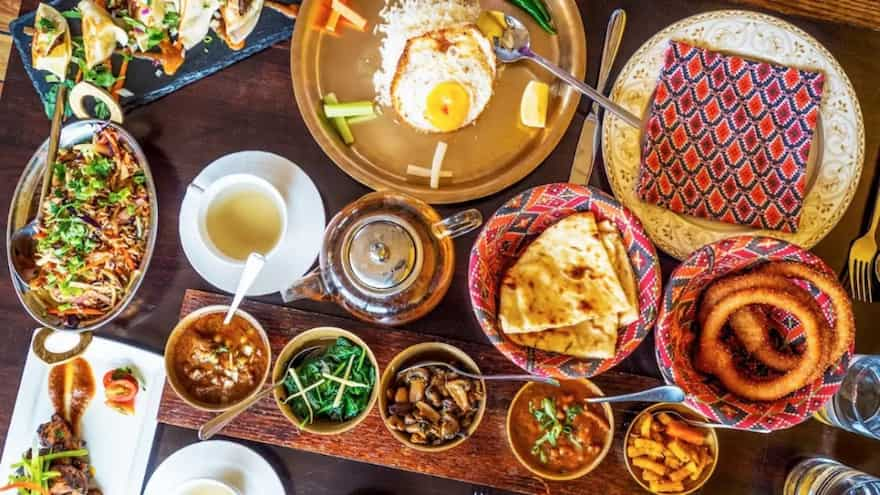Nepali/Nepalese cuisine includes a wide range of cuisines based on ethnicity, soil, and climate, all of which are influenced by Nepal's cultural diversity and geography. A lot of the food is based on Asian themes. Nepal produces a wide range of fruits and nuts, including persimmons, apples, mangoes, tangerines, and kiwis, which are used in local delicacies. Dessert is not a well-known concept in Nepali cuisine, although desserts made with milk, yoghurt, and cheese are frequently consumed as stand-alone meals for breakfast. Grated carrots, semolina, rice, corn, or puffed lotus seeds are sometimes substituted for flour, semolina, rice, corn, or puffed lotus seeds. Lentils, fruits, flour, and thickened milk are all used to make barfi. Nepalese puddings, like other Nepalese sweets, are made with ghee. Lal mohan is cardamom-flavoured sweet dumplings that are deep-fried like fritters and drenched in a cardamom-flavoured sweet syrup.
Nepalese cuisine is a home to different types of cuisines.
 pinterest.com
pinterest.com
Khas cuisine
Their khas cuisine is influenced by the khas community. The Khas people's traditional meal is dal-bhat-tarkari, which they eat twice a day. Due to a scarcity of land suitable for irrigated rice paddies, other crops are used to supplement or even replace rice.
Tibetan cuisine
Tibetan and closely related ethnic groups in the Himalayas and Trans-Himalaya have influenced Himalayan cuisine culturally. People generally prefer warm dishes like soup, thukpa, tea, and strong alcohol due to the cold weather. Alcoholic beverages are made from grains. Butter tea is produced by combining a strong brew of tea with butter or ghyu/ghee and salt. This tea is also widely blended with tsampa flour to form a type of fast snack, which is very popular when travelling.
Thakali cuisine
The Thakali people of the Thak-Khola Valley, an ancient and relatively easy trade route in the high Himalayas, eat Thakali cuisine, which is a cross between Himalayan and lowland cuisines. This cuisine is also provided in Thakali-run inns (bhattis) along other trade routes, as well as in Pokhara and other cities in central Nepal's hills, which were once thought to have the best food and accommodations before the influx of facilities catering to foreign trekkers.
Newar cuisine
Newar food practises are primarily based on basic hill cuisine, but Newar foods can be far more diversified than Pahade/Pahari dishes during religious, ceremonial, and festive occasions. Buffalo meat is widely used in Newari cuisine. Meat and dried fish can be replaced with fried tofu or cottage cheese for vegetarians.
Lohorung Cuisine
Eastern Nepal is home to the Lohorung. Their cuisine includes a wide range of dishes produced with local ingredients. Some of their local ingredients are Wachipa, Wamik, Masikdaam, Sibring, Sel roti, Bawari, Dhule Achar, Saruwa, Chamre, Dibu etc. Limbu cuisine includes kinema (fermented soybeans), yangben (Reindeer Moss), bamboo shoot preparations, millet or buckwheat bread, and the traditional Limbu drink Tongba (millet beer). Some Eastern regions, such as Dharan, eat pork and beef.
Terai cuisine
Mirror cuisines such as Maithili cuisine in the east, Tharu cuisine in the west, and Bhojpuri cuisine in the centre and near west of Nepal's Madhesh area refer to food in the Terai south of the Sivalik Hills. Awadhi cuisine, influenced by Mughlai cuisine, is found further west and is particularly popular among the Muslim community of Nepalganj. Because of the greater range of crops grown locally and cash crops imported from cooler microclimates in surrounding hill regions, as well as from other parts of Greater Nepal, Terai meals can be more varied than those in the Middle Hills.
Some of the best Nepalese dishes to try are-
Dal Bhat
Dal Bhat is a Nepalese staple dish consisting primarily of rice served with lentil soup and vegetable curry or chicken (or meat). This is the most popular dish among Nepali people since it is wholesome and provides adequate nourishment.
Wo or Bara
Wo is a type of pancake prepared by Nepal's Newari people. The Newaris are a Nepalese ethnic group who live in the Kathmandu valley. During the 'Sithi Nakha,' a Newari festival, wo is cooked using ground lentil (green or black) batter. These light dal patties are ideal for snacking. Bara can also be served with minced chicken and a battered egg for non-vegetarians.
Sel Roti
Sel Roti, a hybrid between a doughnut and a bagel, is a popular snack in Nepal during celebrations like Tihar and Dashain. It's a deep-fried circular rice flour bread that's crunchy on the outside and soft on the inside. It's crunchy and sweet, and it's best served with yoghurt or vegetables.
Yomari
Yomari is a festive cuisine in Nepal, eaten solely during the Yomari Punhi festival. It is a sweet delicacy made from rice dough and packed with a sweet paste composed of coconut, sesame seeds, and molasses. Every year in the winter, this festival is held to thank the Gods for a healthy crop. This meal is particularly popular in Kathmandu, and you may also find it in a spicy lentil variant.
Dhido or dhindho
Dhindho or Dhido Thali is a hidden delicacy found in Kathmandu's outskirts, particularly in the Thamel district. It's a thick porridge made by cooking stone-ground cornmeal, buckwheat flour, and millet flour in water with salt. It is served with butter, vegetable curries, pickles, buttermilk, and yoghurt and is the main meal of rural communities.


